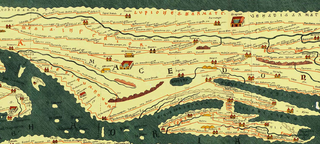The Ministry of Culture of Romania is one of the ministries of the Government of Romania. The current position holder is Lucian Romașcanu from the Social Democratic Party (PSD).

Niculițel is a commune in Tulcea County, Northern Dobruja, Romania. It is composed of a single village, Niculițel.

Săpata is a commune in Argeș County, Muntenia, Romania. It is composed of eight villages: Bănărești, Dealu Bradului, Drăghicești, Găinușa, Lipia, Mârțești, Popești and Turcești.

Amutria was a Dacian town close to the Danube and included in the Roman road network, after the conquest of Dacia.

The Cluj-Napoca City Hall, located at 3 Moților Street, is the seat of government for Cluj-Napoca, Romania. Built at the end of the 19th century after the plans of architect Ignác Alpár, it features a Viennese baroque facade with a corner clock tower. Affixed to the tower was the seal of Kolozs County, of which the city was the seat when it was part of Austria-Hungary before 1918, as the building initially housed the county's headquarters. The building was erected according to the city's 1798 development plan, whereby every new building had to be approved by the city council. During its days as county headquarters, the building served multiple purposes–as a political, administrative and fiscal centre. At the same time, the large halls hosted exhibitions of both established and younger artists, and, starting at the turn of the 20th century, the city's balls.

The castra of Bulci was a fort in the Roman province of Dacia located on the western side of defensive line of forts, limes Daciae. Its ruins are located in Bulci.
Morisena was a castra in the Roman province of Dacia. Morisena was a Roman auxiliary camp and part of the outline in the western fortress chain of the Dacian Limes. It was located within the modern municipality of Cenad, Romania.
It was a fort in the Roman province of Dacia and part of the Roman frontier system of the Limes Transalutanus.
The castra of Basarabi was a fort in the Roman province of Moesia. Its remains are located in Murfatlar (Romania).

Germisara was a fort in the Roman province of Dacia, in modern day Romania, in the village area of Cigmău, in Romania.
The castra of Crâmpoia was a fort in the Roman province of Dacia. It was made of earth in the 2nd century AD. The Romans abandoned the fort in the 3rd century. Its ruins are located in Crâmpoia, Romania.

The castra of Cincșor was a fort in the Roman province of Dacia in the 2nd and 3rd centuries AD and part of the frontier system of the Limes Alutanus.

Gresia Roman fort is located in the present Gresia. It was in the Roman province of Dacia and dates from the 2nd and 3rd centuries AD. It was part of the frontier system of the Limes Transalutanus.
The castra of Ploiești was a Roman fort built in the 2nd century AD. It was abandoned in the same century. Its ruins were unearthed in Ploiești (Romania). Currently, no remains are visible due to the area occupied by the castrum now being a residential area. However, some earthwork-like features can be seen in the uneven surfaces of the roads in the area ("bumps"), and a clearly visible terrace can be observed overlooking the Dâmbu brook, adjacent to the site.
The Castra of Jac was a fort made of earth in the Roman province of Dacia. It was erected in the 2nd century AD. Not far from the fort, the remains of a previous fortification and of a Roman watchtower were unearthed. The fort and the watchtower were abandoned in the 3rd century. Traces of the castra can be identified on Citera Hill in Jac.

Saint Parascheva Church is a Romanian Orthodox church in Desești Commune, Maramureș County, Romania. Built in 1770, it is one of eight buildings that make up the wooden churches of Maramureș UNESCO World Heritage Site, and is also listed as a historic monument by the country's Ministry of Culture and Religious Affairs.

The Mühle House is a historical villa in the Elisabetin district of Timișoara, Romania. The house belonged to the famous family of florists Mühle. It is part of Michael the Brave Boulevard urban ensemble, listed as a historical monument with LMI code TM-II-a-B-06110.

Severin Fortress is a set of historical monuments located on the territory of Drobeta Turnu Severin, Romania. In the National Archaeological Repertory, the monument appears with the code 109782.07.01.

The Reformed church of Mintia in Mintia, Hunedoara County, Romania, is a declared historic monument. It is found in the National Register of Historic Monuments under the code HD-II-m-A-03365.












